Annotated Bibliography on Business Intelligence and Market Trends
VerifiedAdded on 2023/05/29
|13
|3635
|166
Annotated Bibliography
AI Summary
This annotated bibliography compiles and analyzes eight articles related to business intelligence (BI) and related fields. The articles cover a range of topics including market intelligence in sales teams, social business intelligence, cloud networks for BI, the impact of IT on organizational performance, the use of social media in the travel industry, data warehouse virtualization, and the application of BI in sports policy. The summaries highlight each article's main arguments, research methods, findings, and limitations. The analysis reveals the importance of data management, cloud computing, and social media in enhancing business decision-making and improving organizational performance. The bibliography also explores the ethical considerations of data usage and the need for efficient data sharing and analysis. The articles collectively emphasize the critical role of BI in gaining a competitive advantage, making timely decisions, and adapting to market changes. Each annotation includes an assessment of the source's reliability, objectivity, and relevance to the broader topic of business intelligence.

Running head: ANNOTATED BIBLIOGRAPHY 1
Annotated Bibliography
Name
Tutor
Annotated Bibliography
Name
Tutor
Paraphrase This Document
Need a fresh take? Get an instant paraphrase of this document with our AI Paraphraser
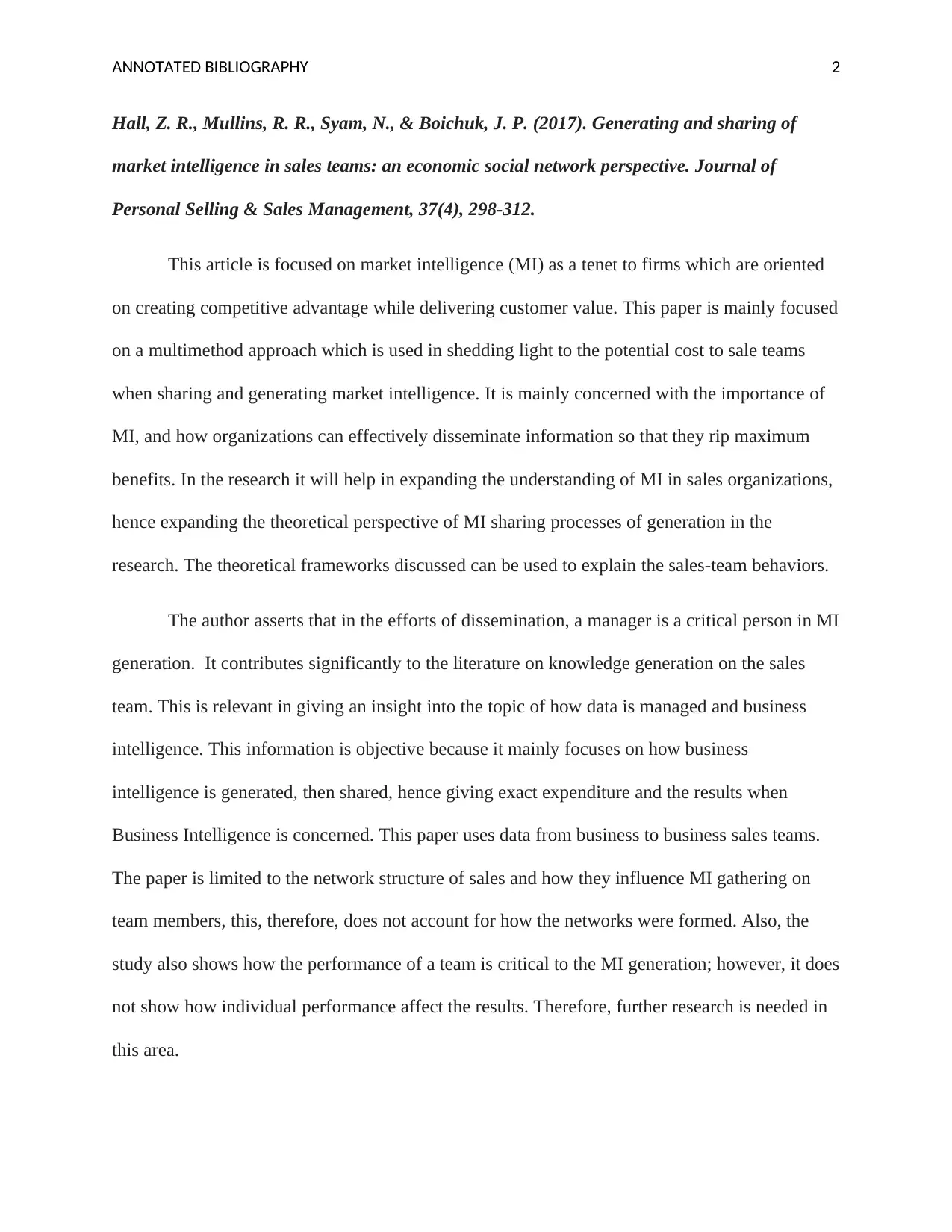
ANNOTATED BIBLIOGRAPHY 2
Hall, Z. R., Mullins, R. R., Syam, N., & Boichuk, J. P. (2017). Generating and sharing of
market intelligence in sales teams: an economic social network perspective. Journal of
Personal Selling & Sales Management, 37(4), 298-312.
This article is focused on market intelligence (MI) as a tenet to firms which are oriented
on creating competitive advantage while delivering customer value. This paper is mainly focused
on a multimethod approach which is used in shedding light to the potential cost to sale teams
when sharing and generating market intelligence. It is mainly concerned with the importance of
MI, and how organizations can effectively disseminate information so that they rip maximum
benefits. In the research it will help in expanding the understanding of MI in sales organizations,
hence expanding the theoretical perspective of MI sharing processes of generation in the
research. The theoretical frameworks discussed can be used to explain the sales-team behaviors.
The author asserts that in the efforts of dissemination, a manager is a critical person in MI
generation. It contributes significantly to the literature on knowledge generation on the sales
team. This is relevant in giving an insight into the topic of how data is managed and business
intelligence. This information is objective because it mainly focuses on how business
intelligence is generated, then shared, hence giving exact expenditure and the results when
Business Intelligence is concerned. This paper uses data from business to business sales teams.
The paper is limited to the network structure of sales and how they influence MI gathering on
team members, this, therefore, does not account for how the networks were formed. Also, the
study also shows how the performance of a team is critical to the MI generation; however, it does
not show how individual performance affect the results. Therefore, further research is needed in
this area.
Hall, Z. R., Mullins, R. R., Syam, N., & Boichuk, J. P. (2017). Generating and sharing of
market intelligence in sales teams: an economic social network perspective. Journal of
Personal Selling & Sales Management, 37(4), 298-312.
This article is focused on market intelligence (MI) as a tenet to firms which are oriented
on creating competitive advantage while delivering customer value. This paper is mainly focused
on a multimethod approach which is used in shedding light to the potential cost to sale teams
when sharing and generating market intelligence. It is mainly concerned with the importance of
MI, and how organizations can effectively disseminate information so that they rip maximum
benefits. In the research it will help in expanding the understanding of MI in sales organizations,
hence expanding the theoretical perspective of MI sharing processes of generation in the
research. The theoretical frameworks discussed can be used to explain the sales-team behaviors.
The author asserts that in the efforts of dissemination, a manager is a critical person in MI
generation. It contributes significantly to the literature on knowledge generation on the sales
team. This is relevant in giving an insight into the topic of how data is managed and business
intelligence. This information is objective because it mainly focuses on how business
intelligence is generated, then shared, hence giving exact expenditure and the results when
Business Intelligence is concerned. This paper uses data from business to business sales teams.
The paper is limited to the network structure of sales and how they influence MI gathering on
team members, this, therefore, does not account for how the networks were formed. Also, the
study also shows how the performance of a team is critical to the MI generation; however, it does
not show how individual performance affect the results. Therefore, further research is needed in
this area.
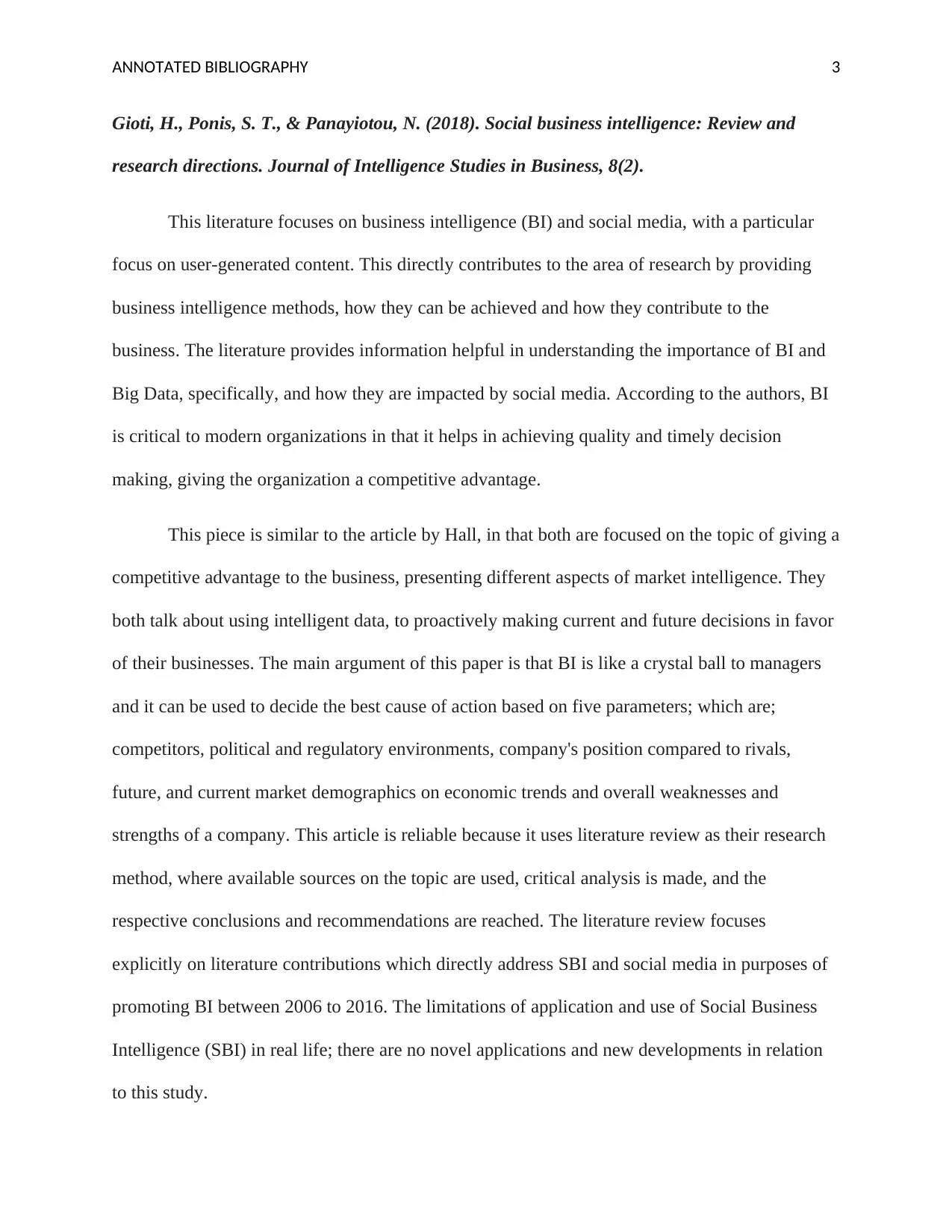
ANNOTATED BIBLIOGRAPHY 3
Gioti, H., Ponis, S. T., & Panayiotou, N. (2018). Social business intelligence: Review and
research directions. Journal of Intelligence Studies in Business, 8(2).
This literature focuses on business intelligence (BI) and social media, with a particular
focus on user-generated content. This directly contributes to the area of research by providing
business intelligence methods, how they can be achieved and how they contribute to the
business. The literature provides information helpful in understanding the importance of BI and
Big Data, specifically, and how they are impacted by social media. According to the authors, BI
is critical to modern organizations in that it helps in achieving quality and timely decision
making, giving the organization a competitive advantage.
This piece is similar to the article by Hall, in that both are focused on the topic of giving a
competitive advantage to the business, presenting different aspects of market intelligence. They
both talk about using intelligent data, to proactively making current and future decisions in favor
of their businesses. The main argument of this paper is that BI is like a crystal ball to managers
and it can be used to decide the best cause of action based on five parameters; which are;
competitors, political and regulatory environments, company's position compared to rivals,
future, and current market demographics on economic trends and overall weaknesses and
strengths of a company. This article is reliable because it uses literature review as their research
method, where available sources on the topic are used, critical analysis is made, and the
respective conclusions and recommendations are reached. The literature review focuses
explicitly on literature contributions which directly address SBI and social media in purposes of
promoting BI between 2006 to 2016. The limitations of application and use of Social Business
Intelligence (SBI) in real life; there are no novel applications and new developments in relation
to this study.
Gioti, H., Ponis, S. T., & Panayiotou, N. (2018). Social business intelligence: Review and
research directions. Journal of Intelligence Studies in Business, 8(2).
This literature focuses on business intelligence (BI) and social media, with a particular
focus on user-generated content. This directly contributes to the area of research by providing
business intelligence methods, how they can be achieved and how they contribute to the
business. The literature provides information helpful in understanding the importance of BI and
Big Data, specifically, and how they are impacted by social media. According to the authors, BI
is critical to modern organizations in that it helps in achieving quality and timely decision
making, giving the organization a competitive advantage.
This piece is similar to the article by Hall, in that both are focused on the topic of giving a
competitive advantage to the business, presenting different aspects of market intelligence. They
both talk about using intelligent data, to proactively making current and future decisions in favor
of their businesses. The main argument of this paper is that BI is like a crystal ball to managers
and it can be used to decide the best cause of action based on five parameters; which are;
competitors, political and regulatory environments, company's position compared to rivals,
future, and current market demographics on economic trends and overall weaknesses and
strengths of a company. This article is reliable because it uses literature review as their research
method, where available sources on the topic are used, critical analysis is made, and the
respective conclusions and recommendations are reached. The literature review focuses
explicitly on literature contributions which directly address SBI and social media in purposes of
promoting BI between 2006 to 2016. The limitations of application and use of Social Business
Intelligence (SBI) in real life; there are no novel applications and new developments in relation
to this study.
⊘ This is a preview!⊘
Do you want full access?
Subscribe today to unlock all pages.

Trusted by 1+ million students worldwide
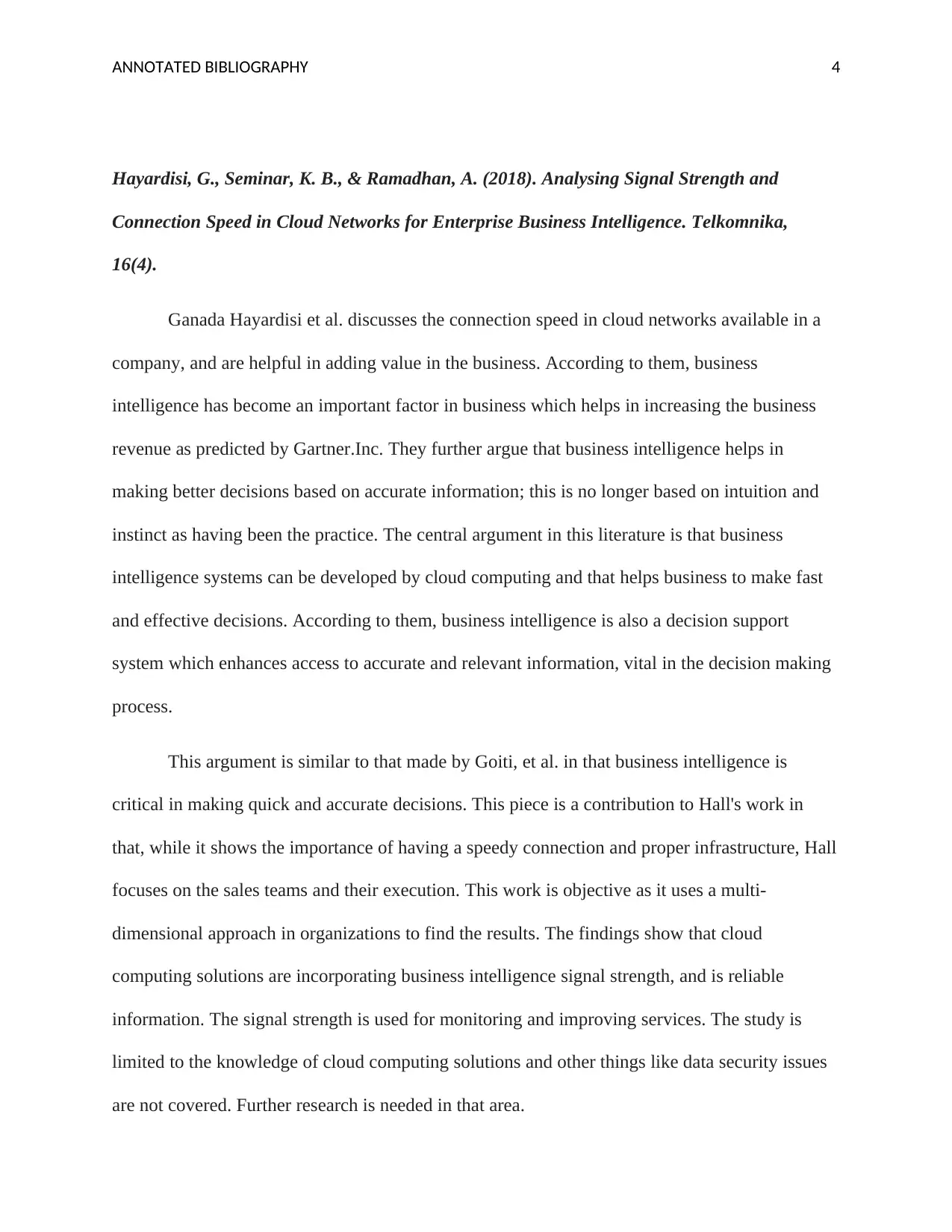
ANNOTATED BIBLIOGRAPHY 4
Hayardisi, G., Seminar, K. B., & Ramadhan, A. (2018). Analysing Signal Strength and
Connection Speed in Cloud Networks for Enterprise Business Intelligence. Telkomnika,
16(4).
Ganada Hayardisi et al. discusses the connection speed in cloud networks available in a
company, and are helpful in adding value in the business. According to them, business
intelligence has become an important factor in business which helps in increasing the business
revenue as predicted by Gartner.Inc. They further argue that business intelligence helps in
making better decisions based on accurate information; this is no longer based on intuition and
instinct as having been the practice. The central argument in this literature is that business
intelligence systems can be developed by cloud computing and that helps business to make fast
and effective decisions. According to them, business intelligence is also a decision support
system which enhances access to accurate and relevant information, vital in the decision making
process.
This argument is similar to that made by Goiti, et al. in that business intelligence is
critical in making quick and accurate decisions. This piece is a contribution to Hall's work in
that, while it shows the importance of having a speedy connection and proper infrastructure, Hall
focuses on the sales teams and their execution. This work is objective as it uses a multi-
dimensional approach in organizations to find the results. The findings show that cloud
computing solutions are incorporating business intelligence signal strength, and is reliable
information. The signal strength is used for monitoring and improving services. The study is
limited to the knowledge of cloud computing solutions and other things like data security issues
are not covered. Further research is needed in that area.
Hayardisi, G., Seminar, K. B., & Ramadhan, A. (2018). Analysing Signal Strength and
Connection Speed in Cloud Networks for Enterprise Business Intelligence. Telkomnika,
16(4).
Ganada Hayardisi et al. discusses the connection speed in cloud networks available in a
company, and are helpful in adding value in the business. According to them, business
intelligence has become an important factor in business which helps in increasing the business
revenue as predicted by Gartner.Inc. They further argue that business intelligence helps in
making better decisions based on accurate information; this is no longer based on intuition and
instinct as having been the practice. The central argument in this literature is that business
intelligence systems can be developed by cloud computing and that helps business to make fast
and effective decisions. According to them, business intelligence is also a decision support
system which enhances access to accurate and relevant information, vital in the decision making
process.
This argument is similar to that made by Goiti, et al. in that business intelligence is
critical in making quick and accurate decisions. This piece is a contribution to Hall's work in
that, while it shows the importance of having a speedy connection and proper infrastructure, Hall
focuses on the sales teams and their execution. This work is objective as it uses a multi-
dimensional approach in organizations to find the results. The findings show that cloud
computing solutions are incorporating business intelligence signal strength, and is reliable
information. The signal strength is used for monitoring and improving services. The study is
limited to the knowledge of cloud computing solutions and other things like data security issues
are not covered. Further research is needed in that area.
Paraphrase This Document
Need a fresh take? Get an instant paraphrase of this document with our AI Paraphraser
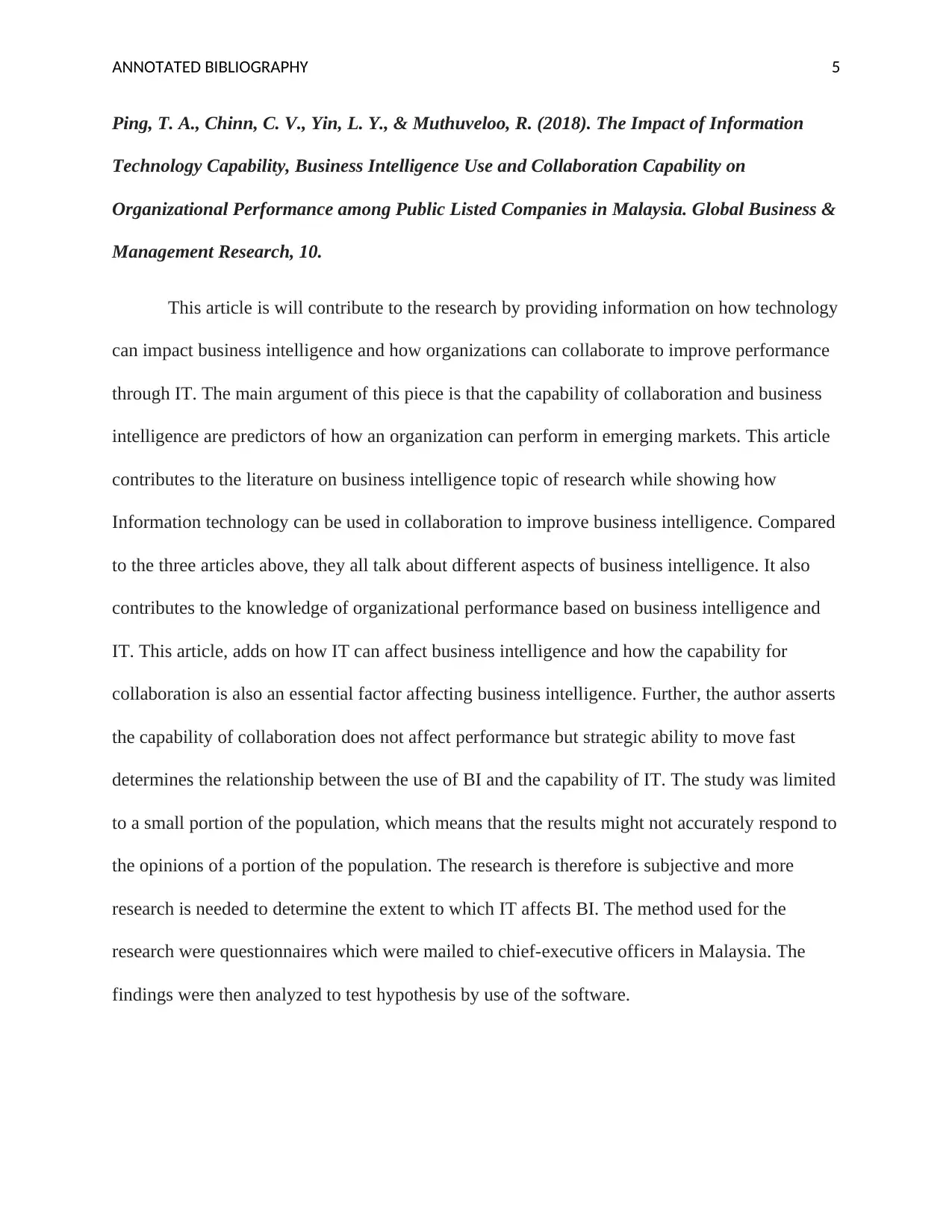
ANNOTATED BIBLIOGRAPHY 5
Ping, T. A., Chinn, C. V., Yin, L. Y., & Muthuveloo, R. (2018). The Impact of Information
Technology Capability, Business Intelligence Use and Collaboration Capability on
Organizational Performance among Public Listed Companies in Malaysia. Global Business &
Management Research, 10.
This article is will contribute to the research by providing information on how technology
can impact business intelligence and how organizations can collaborate to improve performance
through IT. The main argument of this piece is that the capability of collaboration and business
intelligence are predictors of how an organization can perform in emerging markets. This article
contributes to the literature on business intelligence topic of research while showing how
Information technology can be used in collaboration to improve business intelligence. Compared
to the three articles above, they all talk about different aspects of business intelligence. It also
contributes to the knowledge of organizational performance based on business intelligence and
IT. This article, adds on how IT can affect business intelligence and how the capability for
collaboration is also an essential factor affecting business intelligence. Further, the author asserts
the capability of collaboration does not affect performance but strategic ability to move fast
determines the relationship between the use of BI and the capability of IT. The study was limited
to a small portion of the population, which means that the results might not accurately respond to
the opinions of a portion of the population. The research is therefore is subjective and more
research is needed to determine the extent to which IT affects BI. The method used for the
research were questionnaires which were mailed to chief-executive officers in Malaysia. The
findings were then analyzed to test hypothesis by use of the software.
Ping, T. A., Chinn, C. V., Yin, L. Y., & Muthuveloo, R. (2018). The Impact of Information
Technology Capability, Business Intelligence Use and Collaboration Capability on
Organizational Performance among Public Listed Companies in Malaysia. Global Business &
Management Research, 10.
This article is will contribute to the research by providing information on how technology
can impact business intelligence and how organizations can collaborate to improve performance
through IT. The main argument of this piece is that the capability of collaboration and business
intelligence are predictors of how an organization can perform in emerging markets. This article
contributes to the literature on business intelligence topic of research while showing how
Information technology can be used in collaboration to improve business intelligence. Compared
to the three articles above, they all talk about different aspects of business intelligence. It also
contributes to the knowledge of organizational performance based on business intelligence and
IT. This article, adds on how IT can affect business intelligence and how the capability for
collaboration is also an essential factor affecting business intelligence. Further, the author asserts
the capability of collaboration does not affect performance but strategic ability to move fast
determines the relationship between the use of BI and the capability of IT. The study was limited
to a small portion of the population, which means that the results might not accurately respond to
the opinions of a portion of the population. The research is therefore is subjective and more
research is needed to determine the extent to which IT affects BI. The method used for the
research were questionnaires which were mailed to chief-executive officers in Malaysia. The
findings were then analyzed to test hypothesis by use of the software.
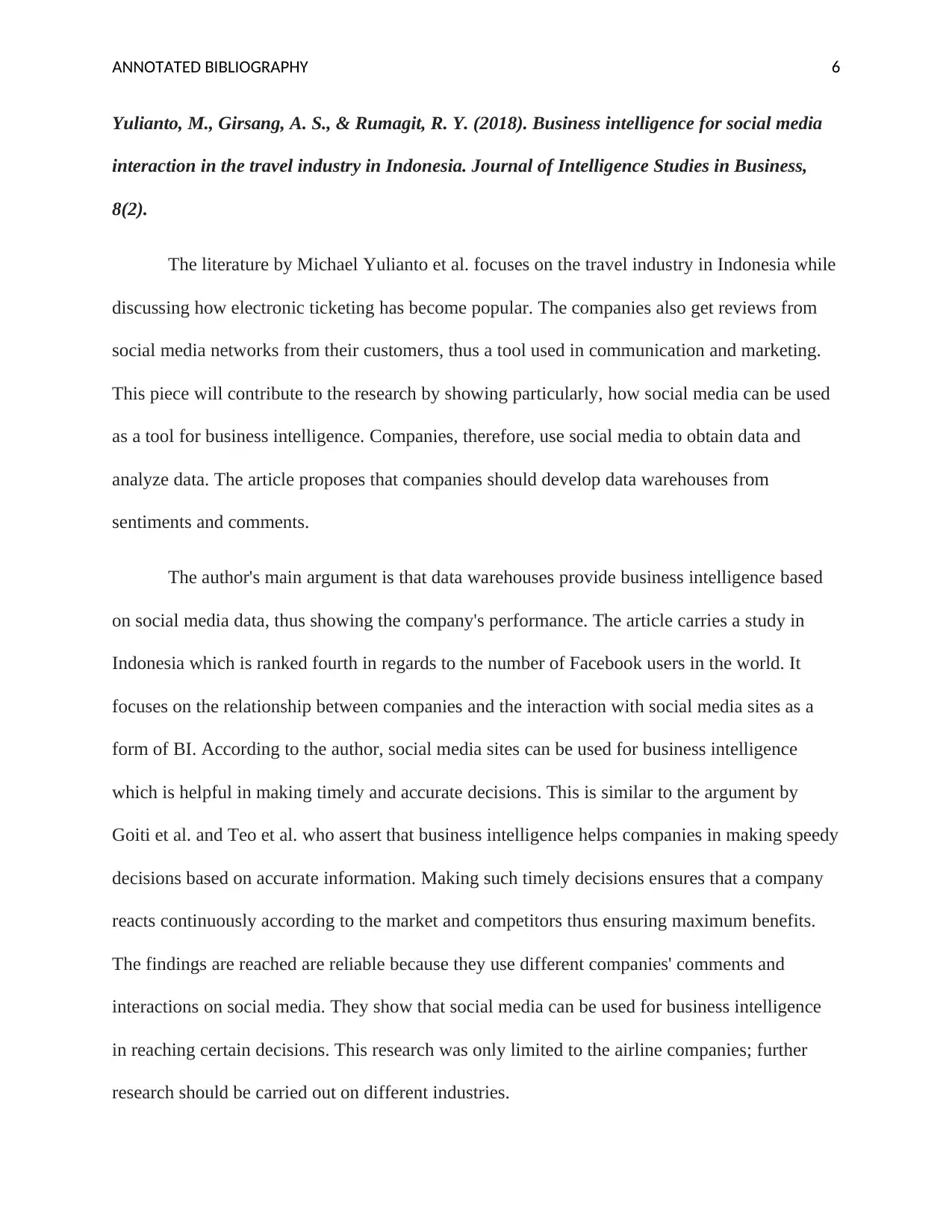
ANNOTATED BIBLIOGRAPHY 6
Yulianto, M., Girsang, A. S., & Rumagit, R. Y. (2018). Business intelligence for social media
interaction in the travel industry in Indonesia. Journal of Intelligence Studies in Business,
8(2).
The literature by Michael Yulianto et al. focuses on the travel industry in Indonesia while
discussing how electronic ticketing has become popular. The companies also get reviews from
social media networks from their customers, thus a tool used in communication and marketing.
This piece will contribute to the research by showing particularly, how social media can be used
as a tool for business intelligence. Companies, therefore, use social media to obtain data and
analyze data. The article proposes that companies should develop data warehouses from
sentiments and comments.
The author's main argument is that data warehouses provide business intelligence based
on social media data, thus showing the company's performance. The article carries a study in
Indonesia which is ranked fourth in regards to the number of Facebook users in the world. It
focuses on the relationship between companies and the interaction with social media sites as a
form of BI. According to the author, social media sites can be used for business intelligence
which is helpful in making timely and accurate decisions. This is similar to the argument by
Goiti et al. and Teo et al. who assert that business intelligence helps companies in making speedy
decisions based on accurate information. Making such timely decisions ensures that a company
reacts continuously according to the market and competitors thus ensuring maximum benefits.
The findings are reached are reliable because they use different companies' comments and
interactions on social media. They show that social media can be used for business intelligence
in reaching certain decisions. This research was only limited to the airline companies; further
research should be carried out on different industries.
Yulianto, M., Girsang, A. S., & Rumagit, R. Y. (2018). Business intelligence for social media
interaction in the travel industry in Indonesia. Journal of Intelligence Studies in Business,
8(2).
The literature by Michael Yulianto et al. focuses on the travel industry in Indonesia while
discussing how electronic ticketing has become popular. The companies also get reviews from
social media networks from their customers, thus a tool used in communication and marketing.
This piece will contribute to the research by showing particularly, how social media can be used
as a tool for business intelligence. Companies, therefore, use social media to obtain data and
analyze data. The article proposes that companies should develop data warehouses from
sentiments and comments.
The author's main argument is that data warehouses provide business intelligence based
on social media data, thus showing the company's performance. The article carries a study in
Indonesia which is ranked fourth in regards to the number of Facebook users in the world. It
focuses on the relationship between companies and the interaction with social media sites as a
form of BI. According to the author, social media sites can be used for business intelligence
which is helpful in making timely and accurate decisions. This is similar to the argument by
Goiti et al. and Teo et al. who assert that business intelligence helps companies in making speedy
decisions based on accurate information. Making such timely decisions ensures that a company
reacts continuously according to the market and competitors thus ensuring maximum benefits.
The findings are reached are reliable because they use different companies' comments and
interactions on social media. They show that social media can be used for business intelligence
in reaching certain decisions. This research was only limited to the airline companies; further
research should be carried out on different industries.
⊘ This is a preview!⊘
Do you want full access?
Subscribe today to unlock all pages.

Trusted by 1+ million students worldwide
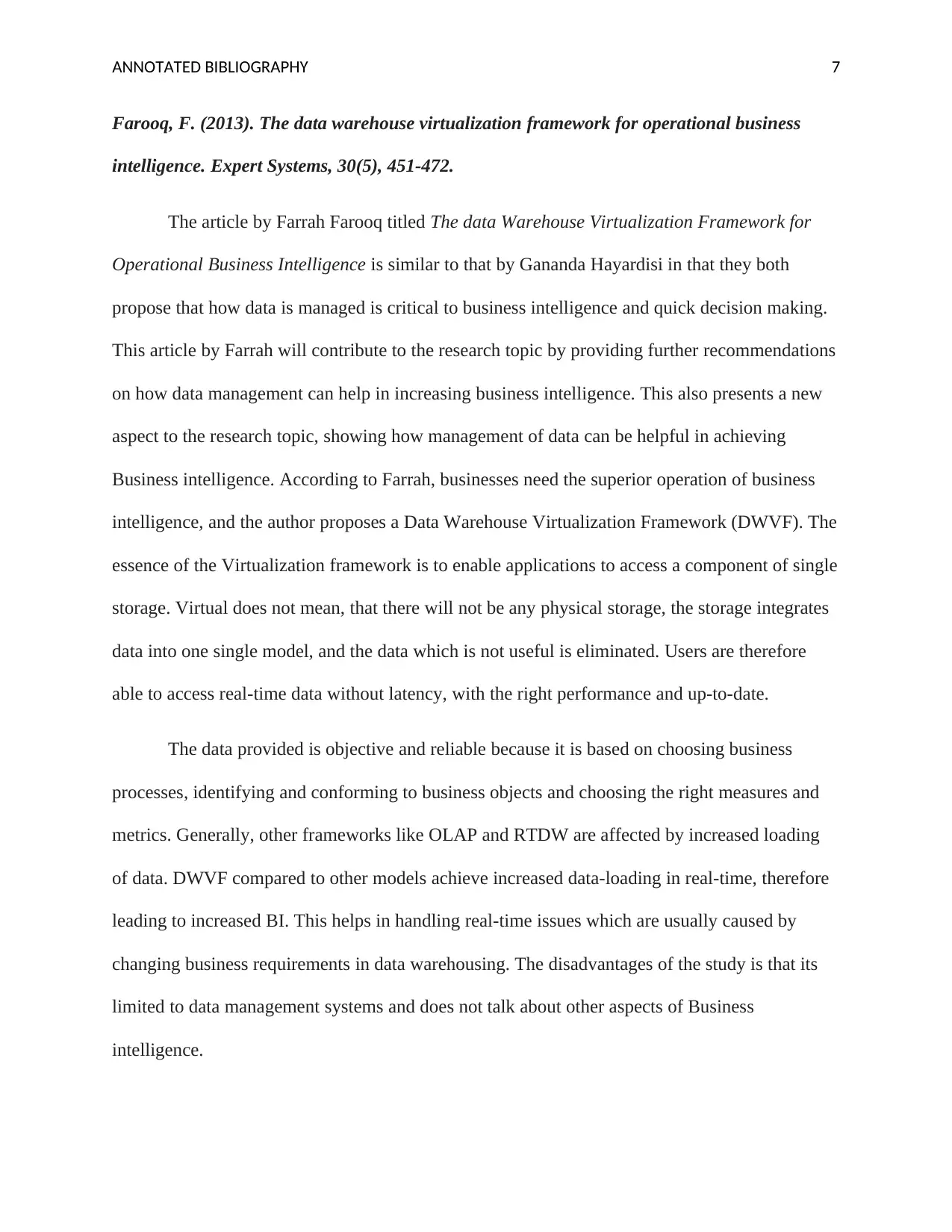
ANNOTATED BIBLIOGRAPHY 7
Farooq, F. (2013). The data warehouse virtualization framework for operational business
intelligence. Expert Systems, 30(5), 451-472.
The article by Farrah Farooq titled The data Warehouse Virtualization Framework for
Operational Business Intelligence is similar to that by Gananda Hayardisi in that they both
propose that how data is managed is critical to business intelligence and quick decision making.
This article by Farrah will contribute to the research topic by providing further recommendations
on how data management can help in increasing business intelligence. This also presents a new
aspect to the research topic, showing how management of data can be helpful in achieving
Business intelligence. According to Farrah, businesses need the superior operation of business
intelligence, and the author proposes a Data Warehouse Virtualization Framework (DWVF). The
essence of the Virtualization framework is to enable applications to access a component of single
storage. Virtual does not mean, that there will not be any physical storage, the storage integrates
data into one single model, and the data which is not useful is eliminated. Users are therefore
able to access real-time data without latency, with the right performance and up-to-date.
The data provided is objective and reliable because it is based on choosing business
processes, identifying and conforming to business objects and choosing the right measures and
metrics. Generally, other frameworks like OLAP and RTDW are affected by increased loading
of data. DWVF compared to other models achieve increased data-loading in real-time, therefore
leading to increased BI. This helps in handling real-time issues which are usually caused by
changing business requirements in data warehousing. The disadvantages of the study is that its
limited to data management systems and does not talk about other aspects of Business
intelligence.
Farooq, F. (2013). The data warehouse virtualization framework for operational business
intelligence. Expert Systems, 30(5), 451-472.
The article by Farrah Farooq titled The data Warehouse Virtualization Framework for
Operational Business Intelligence is similar to that by Gananda Hayardisi in that they both
propose that how data is managed is critical to business intelligence and quick decision making.
This article by Farrah will contribute to the research topic by providing further recommendations
on how data management can help in increasing business intelligence. This also presents a new
aspect to the research topic, showing how management of data can be helpful in achieving
Business intelligence. According to Farrah, businesses need the superior operation of business
intelligence, and the author proposes a Data Warehouse Virtualization Framework (DWVF). The
essence of the Virtualization framework is to enable applications to access a component of single
storage. Virtual does not mean, that there will not be any physical storage, the storage integrates
data into one single model, and the data which is not useful is eliminated. Users are therefore
able to access real-time data without latency, with the right performance and up-to-date.
The data provided is objective and reliable because it is based on choosing business
processes, identifying and conforming to business objects and choosing the right measures and
metrics. Generally, other frameworks like OLAP and RTDW are affected by increased loading
of data. DWVF compared to other models achieve increased data-loading in real-time, therefore
leading to increased BI. This helps in handling real-time issues which are usually caused by
changing business requirements in data warehousing. The disadvantages of the study is that its
limited to data management systems and does not talk about other aspects of Business
intelligence.
Paraphrase This Document
Need a fresh take? Get an instant paraphrase of this document with our AI Paraphraser
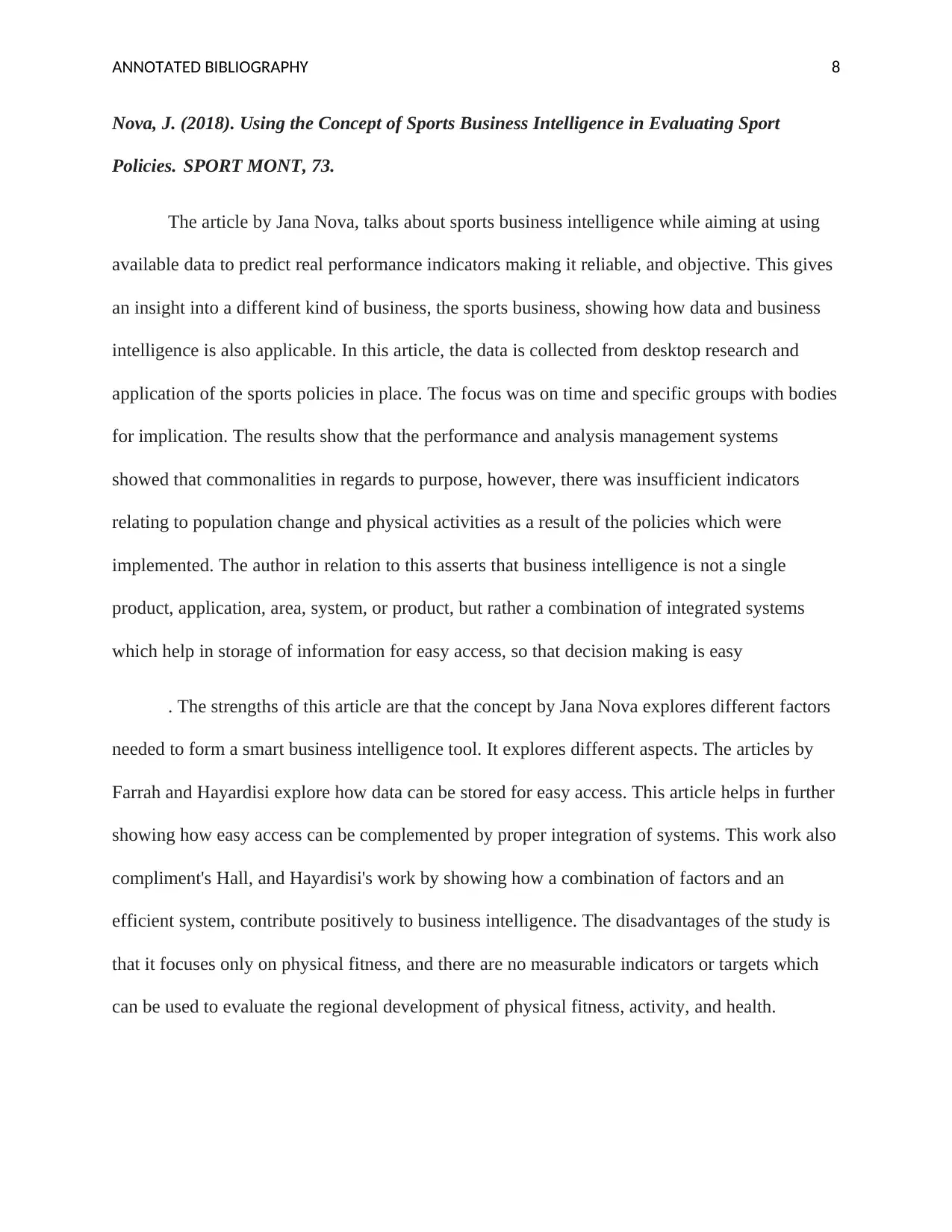
ANNOTATED BIBLIOGRAPHY 8
Nova, J. (2018). Using the Concept of Sports Business Intelligence in Evaluating Sport
Policies. SPORT MONT, 73.
The article by Jana Nova, talks about sports business intelligence while aiming at using
available data to predict real performance indicators making it reliable, and objective. This gives
an insight into a different kind of business, the sports business, showing how data and business
intelligence is also applicable. In this article, the data is collected from desktop research and
application of the sports policies in place. The focus was on time and specific groups with bodies
for implication. The results show that the performance and analysis management systems
showed that commonalities in regards to purpose, however, there was insufficient indicators
relating to population change and physical activities as a result of the policies which were
implemented. The author in relation to this asserts that business intelligence is not a single
product, application, area, system, or product, but rather a combination of integrated systems
which help in storage of information for easy access, so that decision making is easy
. The strengths of this article are that the concept by Jana Nova explores different factors
needed to form a smart business intelligence tool. It explores different aspects. The articles by
Farrah and Hayardisi explore how data can be stored for easy access. This article helps in further
showing how easy access can be complemented by proper integration of systems. This work also
compliment's Hall, and Hayardisi's work by showing how a combination of factors and an
efficient system, contribute positively to business intelligence. The disadvantages of the study is
that it focuses only on physical fitness, and there are no measurable indicators or targets which
can be used to evaluate the regional development of physical fitness, activity, and health.
Nova, J. (2018). Using the Concept of Sports Business Intelligence in Evaluating Sport
Policies. SPORT MONT, 73.
The article by Jana Nova, talks about sports business intelligence while aiming at using
available data to predict real performance indicators making it reliable, and objective. This gives
an insight into a different kind of business, the sports business, showing how data and business
intelligence is also applicable. In this article, the data is collected from desktop research and
application of the sports policies in place. The focus was on time and specific groups with bodies
for implication. The results show that the performance and analysis management systems
showed that commonalities in regards to purpose, however, there was insufficient indicators
relating to population change and physical activities as a result of the policies which were
implemented. The author in relation to this asserts that business intelligence is not a single
product, application, area, system, or product, but rather a combination of integrated systems
which help in storage of information for easy access, so that decision making is easy
. The strengths of this article are that the concept by Jana Nova explores different factors
needed to form a smart business intelligence tool. It explores different aspects. The articles by
Farrah and Hayardisi explore how data can be stored for easy access. This article helps in further
showing how easy access can be complemented by proper integration of systems. This work also
compliment's Hall, and Hayardisi's work by showing how a combination of factors and an
efficient system, contribute positively to business intelligence. The disadvantages of the study is
that it focuses only on physical fitness, and there are no measurable indicators or targets which
can be used to evaluate the regional development of physical fitness, activity, and health.
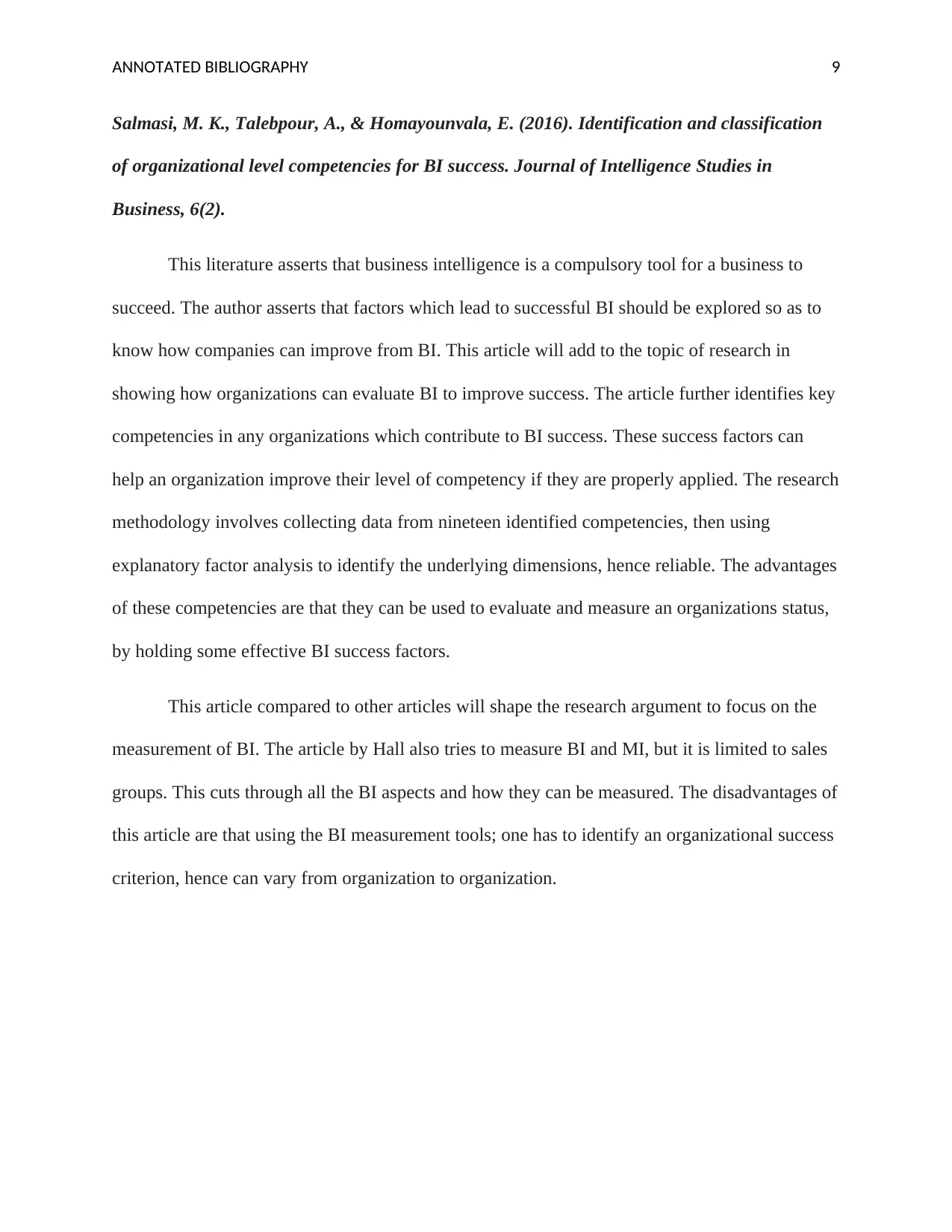
ANNOTATED BIBLIOGRAPHY 9
Salmasi, M. K., Talebpour, A., & Homayounvala, E. (2016). Identification and classification
of organizational level competencies for BI success. Journal of Intelligence Studies in
Business, 6(2).
This literature asserts that business intelligence is a compulsory tool for a business to
succeed. The author asserts that factors which lead to successful BI should be explored so as to
know how companies can improve from BI. This article will add to the topic of research in
showing how organizations can evaluate BI to improve success. The article further identifies key
competencies in any organizations which contribute to BI success. These success factors can
help an organization improve their level of competency if they are properly applied. The research
methodology involves collecting data from nineteen identified competencies, then using
explanatory factor analysis to identify the underlying dimensions, hence reliable. The advantages
of these competencies are that they can be used to evaluate and measure an organizations status,
by holding some effective BI success factors.
This article compared to other articles will shape the research argument to focus on the
measurement of BI. The article by Hall also tries to measure BI and MI, but it is limited to sales
groups. This cuts through all the BI aspects and how they can be measured. The disadvantages of
this article are that using the BI measurement tools; one has to identify an organizational success
criterion, hence can vary from organization to organization.
Salmasi, M. K., Talebpour, A., & Homayounvala, E. (2016). Identification and classification
of organizational level competencies for BI success. Journal of Intelligence Studies in
Business, 6(2).
This literature asserts that business intelligence is a compulsory tool for a business to
succeed. The author asserts that factors which lead to successful BI should be explored so as to
know how companies can improve from BI. This article will add to the topic of research in
showing how organizations can evaluate BI to improve success. The article further identifies key
competencies in any organizations which contribute to BI success. These success factors can
help an organization improve their level of competency if they are properly applied. The research
methodology involves collecting data from nineteen identified competencies, then using
explanatory factor analysis to identify the underlying dimensions, hence reliable. The advantages
of these competencies are that they can be used to evaluate and measure an organizations status,
by holding some effective BI success factors.
This article compared to other articles will shape the research argument to focus on the
measurement of BI. The article by Hall also tries to measure BI and MI, but it is limited to sales
groups. This cuts through all the BI aspects and how they can be measured. The disadvantages of
this article are that using the BI measurement tools; one has to identify an organizational success
criterion, hence can vary from organization to organization.
⊘ This is a preview!⊘
Do you want full access?
Subscribe today to unlock all pages.

Trusted by 1+ million students worldwide
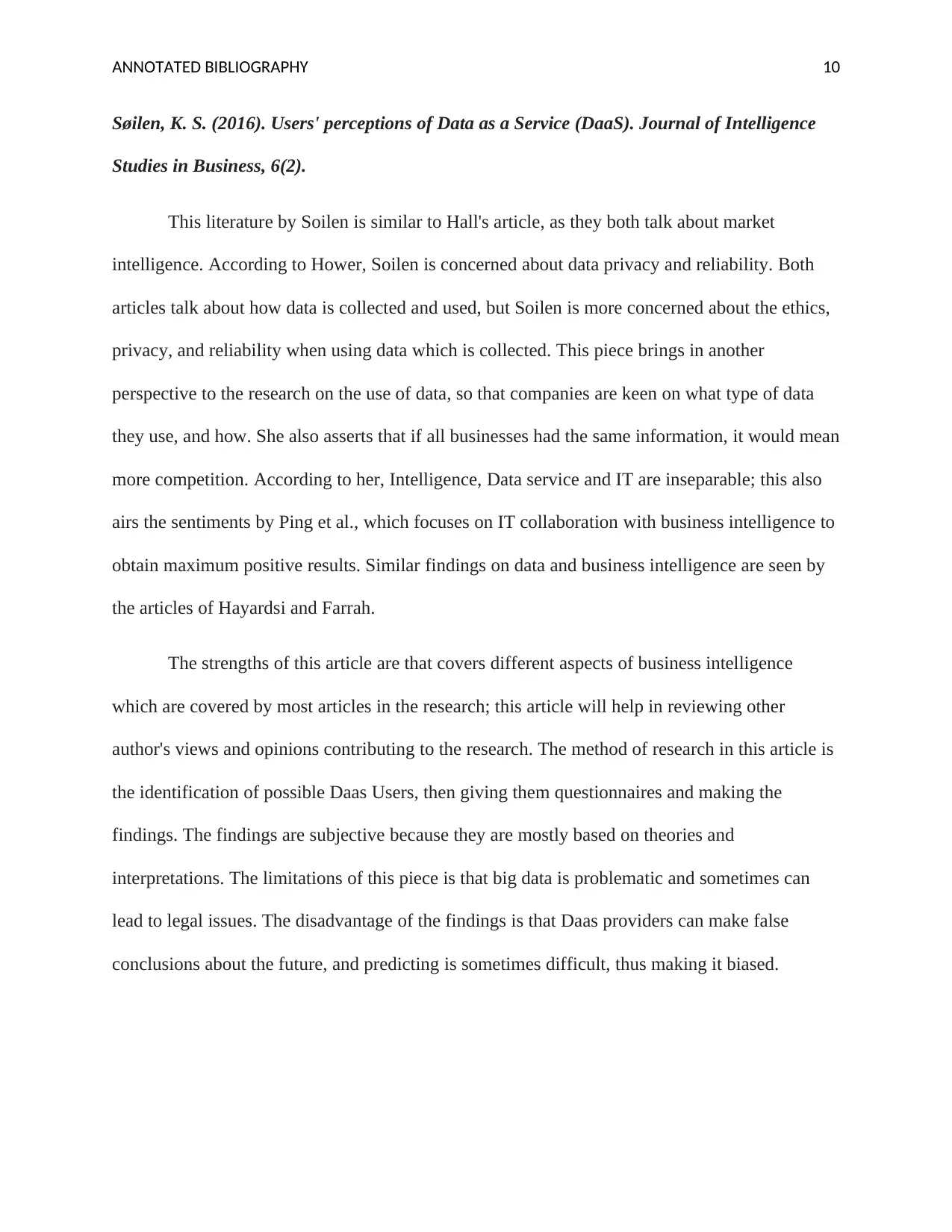
ANNOTATED BIBLIOGRAPHY 10
Søilen, K. S. (2016). Users' perceptions of Data as a Service (DaaS). Journal of Intelligence
Studies in Business, 6(2).
This literature by Soilen is similar to Hall's article, as they both talk about market
intelligence. According to Hower, Soilen is concerned about data privacy and reliability. Both
articles talk about how data is collected and used, but Soilen is more concerned about the ethics,
privacy, and reliability when using data which is collected. This piece brings in another
perspective to the research on the use of data, so that companies are keen on what type of data
they use, and how. She also asserts that if all businesses had the same information, it would mean
more competition. According to her, Intelligence, Data service and IT are inseparable; this also
airs the sentiments by Ping et al., which focuses on IT collaboration with business intelligence to
obtain maximum positive results. Similar findings on data and business intelligence are seen by
the articles of Hayardsi and Farrah.
The strengths of this article are that covers different aspects of business intelligence
which are covered by most articles in the research; this article will help in reviewing other
author's views and opinions contributing to the research. The method of research in this article is
the identification of possible Daas Users, then giving them questionnaires and making the
findings. The findings are subjective because they are mostly based on theories and
interpretations. The limitations of this piece is that big data is problematic and sometimes can
lead to legal issues. The disadvantage of the findings is that Daas providers can make false
conclusions about the future, and predicting is sometimes difficult, thus making it biased.
Søilen, K. S. (2016). Users' perceptions of Data as a Service (DaaS). Journal of Intelligence
Studies in Business, 6(2).
This literature by Soilen is similar to Hall's article, as they both talk about market
intelligence. According to Hower, Soilen is concerned about data privacy and reliability. Both
articles talk about how data is collected and used, but Soilen is more concerned about the ethics,
privacy, and reliability when using data which is collected. This piece brings in another
perspective to the research on the use of data, so that companies are keen on what type of data
they use, and how. She also asserts that if all businesses had the same information, it would mean
more competition. According to her, Intelligence, Data service and IT are inseparable; this also
airs the sentiments by Ping et al., which focuses on IT collaboration with business intelligence to
obtain maximum positive results. Similar findings on data and business intelligence are seen by
the articles of Hayardsi and Farrah.
The strengths of this article are that covers different aspects of business intelligence
which are covered by most articles in the research; this article will help in reviewing other
author's views and opinions contributing to the research. The method of research in this article is
the identification of possible Daas Users, then giving them questionnaires and making the
findings. The findings are subjective because they are mostly based on theories and
interpretations. The limitations of this piece is that big data is problematic and sometimes can
lead to legal issues. The disadvantage of the findings is that Daas providers can make false
conclusions about the future, and predicting is sometimes difficult, thus making it biased.
Paraphrase This Document
Need a fresh take? Get an instant paraphrase of this document with our AI Paraphraser
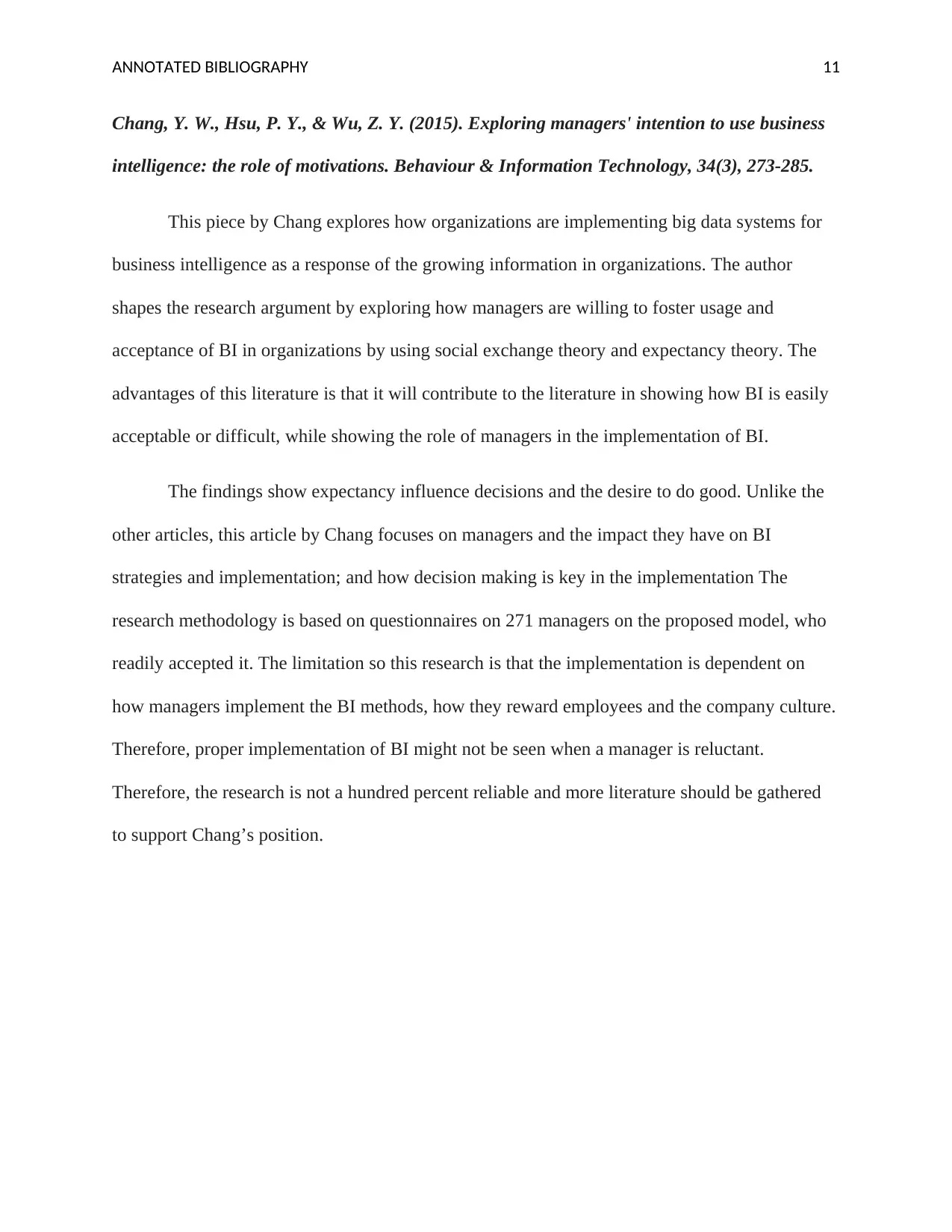
ANNOTATED BIBLIOGRAPHY 11
Chang, Y. W., Hsu, P. Y., & Wu, Z. Y. (2015). Exploring managers' intention to use business
intelligence: the role of motivations. Behaviour & Information Technology, 34(3), 273-285.
This piece by Chang explores how organizations are implementing big data systems for
business intelligence as a response of the growing information in organizations. The author
shapes the research argument by exploring how managers are willing to foster usage and
acceptance of BI in organizations by using social exchange theory and expectancy theory. The
advantages of this literature is that it will contribute to the literature in showing how BI is easily
acceptable or difficult, while showing the role of managers in the implementation of BI.
The findings show expectancy influence decisions and the desire to do good. Unlike the
other articles, this article by Chang focuses on managers and the impact they have on BI
strategies and implementation; and how decision making is key in the implementation The
research methodology is based on questionnaires on 271 managers on the proposed model, who
readily accepted it. The limitation so this research is that the implementation is dependent on
how managers implement the BI methods, how they reward employees and the company culture.
Therefore, proper implementation of BI might not be seen when a manager is reluctant.
Therefore, the research is not a hundred percent reliable and more literature should be gathered
to support Chang’s position.
Chang, Y. W., Hsu, P. Y., & Wu, Z. Y. (2015). Exploring managers' intention to use business
intelligence: the role of motivations. Behaviour & Information Technology, 34(3), 273-285.
This piece by Chang explores how organizations are implementing big data systems for
business intelligence as a response of the growing information in organizations. The author
shapes the research argument by exploring how managers are willing to foster usage and
acceptance of BI in organizations by using social exchange theory and expectancy theory. The
advantages of this literature is that it will contribute to the literature in showing how BI is easily
acceptable or difficult, while showing the role of managers in the implementation of BI.
The findings show expectancy influence decisions and the desire to do good. Unlike the
other articles, this article by Chang focuses on managers and the impact they have on BI
strategies and implementation; and how decision making is key in the implementation The
research methodology is based on questionnaires on 271 managers on the proposed model, who
readily accepted it. The limitation so this research is that the implementation is dependent on
how managers implement the BI methods, how they reward employees and the company culture.
Therefore, proper implementation of BI might not be seen when a manager is reluctant.
Therefore, the research is not a hundred percent reliable and more literature should be gathered
to support Chang’s position.
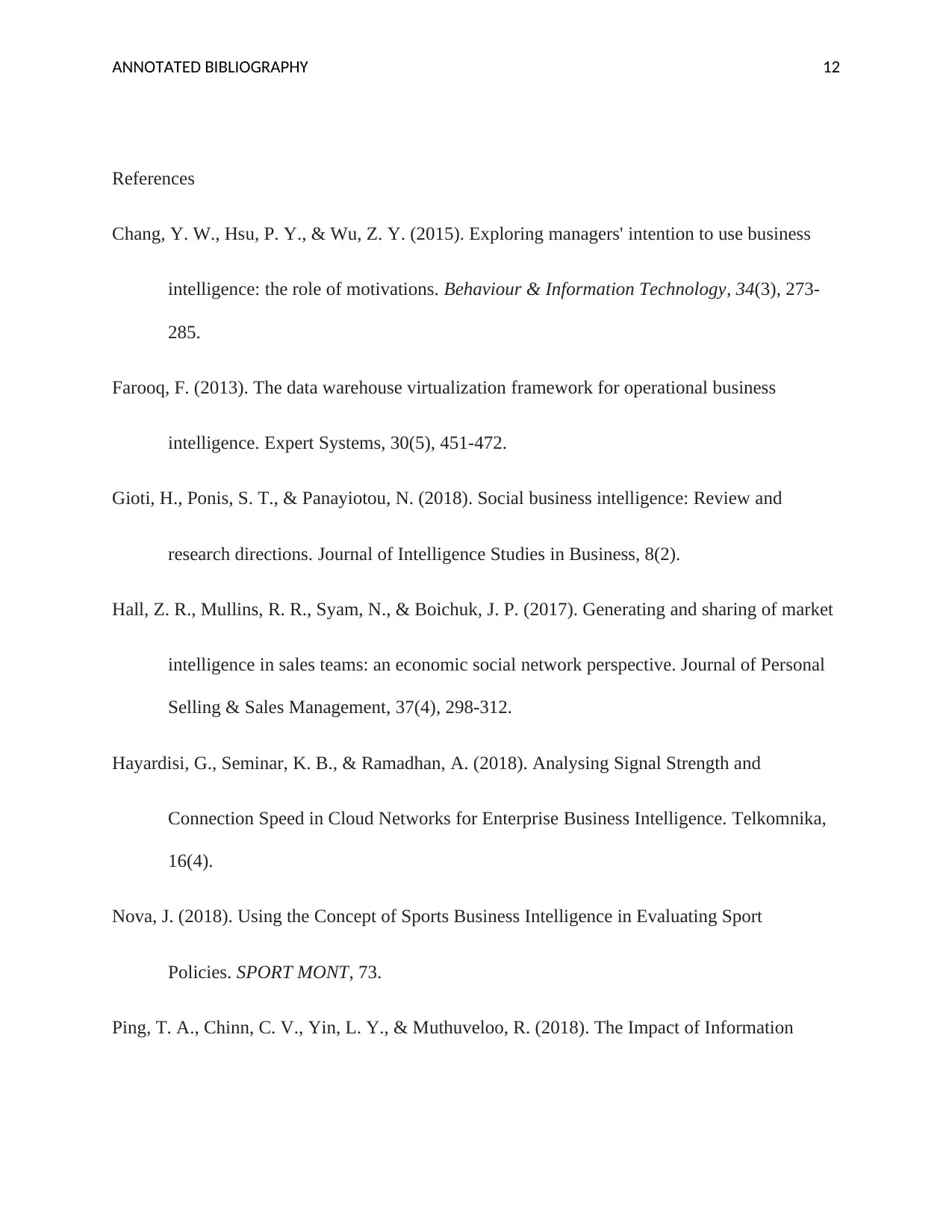
ANNOTATED BIBLIOGRAPHY 12
References
Chang, Y. W., Hsu, P. Y., & Wu, Z. Y. (2015). Exploring managers' intention to use business
intelligence: the role of motivations. Behaviour & Information Technology, 34(3), 273-
285.
Farooq, F. (2013). The data warehouse virtualization framework for operational business
intelligence. Expert Systems, 30(5), 451-472.
Gioti, H., Ponis, S. T., & Panayiotou, N. (2018). Social business intelligence: Review and
research directions. Journal of Intelligence Studies in Business, 8(2).
Hall, Z. R., Mullins, R. R., Syam, N., & Boichuk, J. P. (2017). Generating and sharing of market
intelligence in sales teams: an economic social network perspective. Journal of Personal
Selling & Sales Management, 37(4), 298-312.
Hayardisi, G., Seminar, K. B., & Ramadhan, A. (2018). Analysing Signal Strength and
Connection Speed in Cloud Networks for Enterprise Business Intelligence. Telkomnika,
16(4).
Nova, J. (2018). Using the Concept of Sports Business Intelligence in Evaluating Sport
Policies. SPORT MONT, 73.
Ping, T. A., Chinn, C. V., Yin, L. Y., & Muthuveloo, R. (2018). The Impact of Information
References
Chang, Y. W., Hsu, P. Y., & Wu, Z. Y. (2015). Exploring managers' intention to use business
intelligence: the role of motivations. Behaviour & Information Technology, 34(3), 273-
285.
Farooq, F. (2013). The data warehouse virtualization framework for operational business
intelligence. Expert Systems, 30(5), 451-472.
Gioti, H., Ponis, S. T., & Panayiotou, N. (2018). Social business intelligence: Review and
research directions. Journal of Intelligence Studies in Business, 8(2).
Hall, Z. R., Mullins, R. R., Syam, N., & Boichuk, J. P. (2017). Generating and sharing of market
intelligence in sales teams: an economic social network perspective. Journal of Personal
Selling & Sales Management, 37(4), 298-312.
Hayardisi, G., Seminar, K. B., & Ramadhan, A. (2018). Analysing Signal Strength and
Connection Speed in Cloud Networks for Enterprise Business Intelligence. Telkomnika,
16(4).
Nova, J. (2018). Using the Concept of Sports Business Intelligence in Evaluating Sport
Policies. SPORT MONT, 73.
Ping, T. A., Chinn, C. V., Yin, L. Y., & Muthuveloo, R. (2018). The Impact of Information
⊘ This is a preview!⊘
Do you want full access?
Subscribe today to unlock all pages.

Trusted by 1+ million students worldwide
1 out of 13
Related Documents
Your All-in-One AI-Powered Toolkit for Academic Success.
+13062052269
info@desklib.com
Available 24*7 on WhatsApp / Email
![[object Object]](/_next/static/media/star-bottom.7253800d.svg)
Unlock your academic potential
Copyright © 2020–2025 A2Z Services. All Rights Reserved. Developed and managed by ZUCOL.





